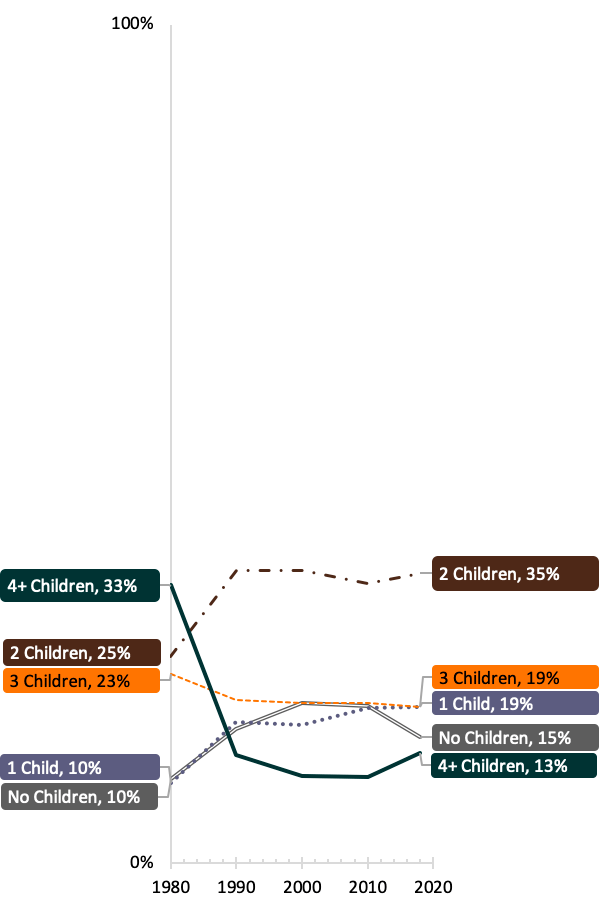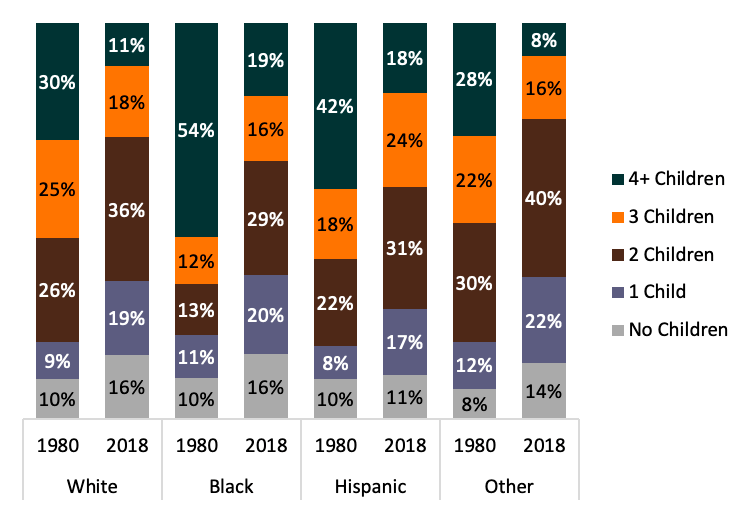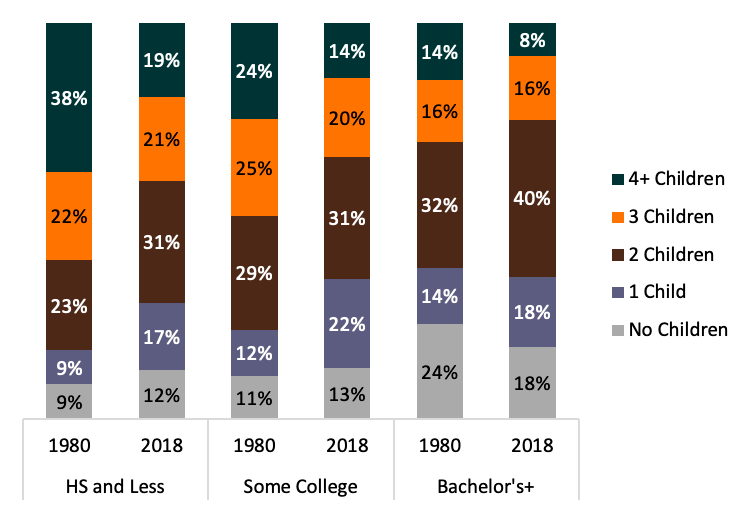Number of Children to Women Aged 40-44, 1980-2018
Family Profile No. 04, 2020
Authors: Karen Benjamin Guzzo and Valerie Schweizer
Birth rates in the U.S. have steadily declined since the Great Recession. The Total Fertility Rate (TFR), which estimates the average number of births women will have if they experience current birth rates throughout their childbearing years, is at a record low of 1.73 births per woman (Martin, Hamilton, Osterman, & Driscoll, 2019). However, the TFR does not reflect changes in birth timing, and delayed fertility is on the rise. While birth rates have fallen at younger ages, they have risen for women 35 and older. As such, looking at actual completed fertility provides another way of examining women’s fertility. In this profile, we use data from the Current Population Survey’s (CPS) biennial June Fertility Supplement for the years 1980 through 2018 to analyze completed fertility for women aged 40-44. We present trends in the distribution of children ever born (one, two, three, or four or more) for women aged 40-44 for the overall population and by race-ethnicity and education. A companion profile (FP-20-03) focuses on trends in children ever born by union status, with information on differentials in age at first birth in 2018 discussed in FP-20-05.
Overall Trends in the Distribution of Children Ever Born
Although the longer-term trend has been toward smaller families, much of the change appears to have occurred prior to 1990. In 2018, 67% of women at the end of their childbearing years had two or more children.
- The percentage of women aged 40 to 44 who did not have a child increased from 10% in 1980 to 19% in 2000 and 2010 but has since declined (to 15% in 2018).
- Those who only have one child increased from 10% in 1980 to 19% in 2000 and has remained stable since.
- Having two children has been the most common pattern since 1990, at 35% of women in 2018.
- The proportion of women with three children has remained stable for nearly three decades, with about 19% of women in this category from 1990 to 2018.
- Women with four or more children were the modal category in 1980 (33%) but represented the lowest percentage of women in 2018 (13%).
- There has been a modest increase in women with four or more children in recent years, rising from 10% in 2010 to 13% in 2018.
Figure 1. Number of Children to Women Aged 40-44, 1980-2018

Trends in Distribution of Children Ever Born by Race-Ethnicity
- In general, all race-ethnic groups experienced declines in large families and growth in childlessness between 1980 and 2018.
- Childlessness increased across most groups from 1980 to 2018, increasing by six percentage points for White, Black, and Other-race women.
- Having only one child became more common from 1980 to 2018 across all groups for women 40-44.
- By 2018, having two children was the most common completed family size regardless of race-ethnicity.
- For Black and Hispanic women, the percentage with three children rose whereas this fell for White women.
- Large families—those with four or more children—declined dramatically across all groups.
Figure 2. Number of Children to Women Aged 40-44 by Race, 1980 & 2018

Trends in the Distribution of Children Ever Born by Education
Trends in completed family size varied slightly by educational attainment.
- Women with a Bachelor’s degree or higher were the only group to experience a decrease in childlessness from 1980 (24%) to 2018 (18%).
- Women aged 40-44 with a Bachelor’s degree had the smallest increase in the percentage with only one child.
- Those with some college who had only one child nearly doubled from 12% in 1980 to 22% in 2018.
- By 2018, the modal number of children ever born was two across categories.
- In 1990, women with a high school education or less most commonly had four or more children (38%), but this percentage was halved by 2018 (19%).
Figure 3. Number of Children to Women Aged 40-44 by Education, 1980 & 2018

Data Sources
- Flood, S., King, M., Rodgers, R., Ruggles, S., & Warren, J. R. (2019). Integrated Public Use Microdata Series, Current Population Survey: Version 7.0 [dataset]. Minneapolis, MN: IPUMS. https://doi.org/10.18128/D030.V7.0
References
- Martin, J. A., Hamilton, B. E., Osterman, M. J. K., & Driscoll, A. K. (2019). Births: Final Data for 2018. National Vital Statistics Reports, 68(13). https://www.cdc.gov/nchs/data/nvsr/nvsr68/nvsr68_13-508.pdf
Suggested Citation
- Guzzo, K. B. & Schweizer, V. (2020). Number of Children to Women Aged 40-44, 1980-2018. Family Profiles, FP-20-04. National Center for Family & Marriage Research.
Updated: 11/07/2025 03:56PM


